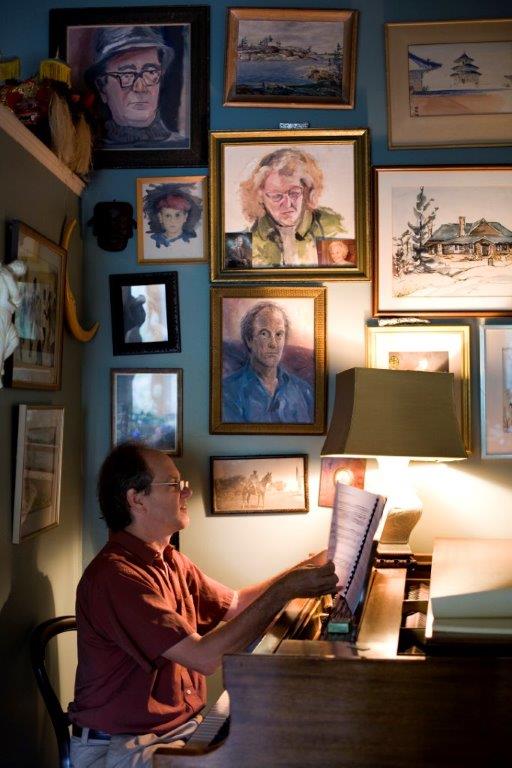by GAC and Peter Skoggard
Local composer Peter Skoggard has developed a new concert experience for audiences this season. LARGER THAN LIFE comes to the Wellington County Museum and Archives on Friday, November 30, at 7:30pm, featuring local and international musicians performing the music of Leonard Bernstein as well as original compositions by Peter Skoggard.
Peter at his piano (photo by Tara Scroi)
Soprano Marion Samuel-Stevens from Rockwood, tenor Robert Missen of Burlington, pianist Daniel Wnukowski of Collingwood, pianist Christopher Burton of Thornbury, and pianist Irene Gregorio of Guelph will perform, as well as one of Canada’s most reknowned string quartets, the Penderecki String Quartet of Wilfrid Laurier University.
Songs and duets from the works of Leonard Bernstein, some from West Side Story, some from On the Town, make up the first half of the concert. Also included will be settings of poems by poets Billy Collins and T.S. Eliot, composed and performed by Skoggard. Daniel Wnukoski is a Polish Canadian pianist living in Vienna, Austria and Collingwood, who will dazzle audiences with his amazing virtuosity and musical depth of emotion. He recently revived the music of Jewish composers who suffered under the Nazi regime, some surviving, some not. Wnukowski will be performing the piano version of George Gershwin’s Rhapsody in Blue.
After intermission, Burton and the Pendercki Quartet will perform Skoggard’s Piano Quintet in seven movements: ROMA.
The performance begins at 7:30 at the Wellington County Museum. Tickets are $40 at the door. To purchase tickets in advance, call 226 203-3595.
Composer Peter Skoggard comments on the string quartet as a musical form and the inspiration behind the concert:
“I often liken the string quartet to the art of drawing, and orchestral works as the art of painting.
All the skill of a visual artist is seen when the medium is most restricted, for example in a black and white drawing. So to draw a scene or a face with only the black of the pencil and the white of the page, to get gradations of light, the illusion of things receding and coming forward, the texture of leaves against bark, or the glisten of eye against eyelash, this is the greater skill. The string quartet presents a similar challenge; there is only the single colour (type of sound) of the strings that is available. Therefore, the composer must depend on the varieties of musical form and harmonies, different registers and rhythms rather than the colours and tones offered by the instruments of a full orchestra.
The starkness of colour makes higher demands on the composer, and composers have traditionally used string quartets to express their most intimate, exalted emotions, and to suggest some cosmic order in melody and harmony.
Music, to my mind, is the most expressive of the arts, that is, can most accurately relay human emotion, for it speaks without definitions, and propels one to the edge of human experience. The compulsion towards eternity.
T.S. Eliot, for all his faults, was a poet preoccupied with this, especially in his Four Quartets.
His Journey of the Magi prefigure this as well. Billy Collins is a poet, that for me, puts eternity into small things, and keeps within a certain sphere of charm and safety while hinting at larger things.
I call the concert LARGER THAN LIFE. Leonard Bernstein was certainly a figure who was larger than life in so many ways. Not least of all, he was masterful and unique in his musical creation.
And then Rome. Rome is the Eternal City, which is apt. Though there are older cities and more beautiful cities, and cities which at various times in history were more important, no city can quite compete with Rome’s overall magnitude: centre of the Roman Empire, centre of the Catholic Church, capital of the secular Italian state. Even these claims are at odds with each other.
One does not blot out the other. Popes long struggled with the contradiction that, although in their minds Christianity was superior to pagan civilization, evidence was littered all about that the Roman Empire was so much grander in its architectural and sculptural achievements.
This drove Julius II, Bramante, and several architects to conceive of a church to outshine the Pantheon and the Basilica of Maxentius. This is why Sixtus V crowned Egyptian obelisks and columns with crosses and statues of the Virgin Mary and St. Peter.
It is also why Michelangelo and Bernini were so important to the Christian argument. There were even official exorcisms of the city involved: Rome was not only the city of Saints Peter and Paul, but also of Satan. These contradictions keep Rome universal. It is these aspects that I hope to capture in my piano quintet Roma.
Peter Skoggard”








